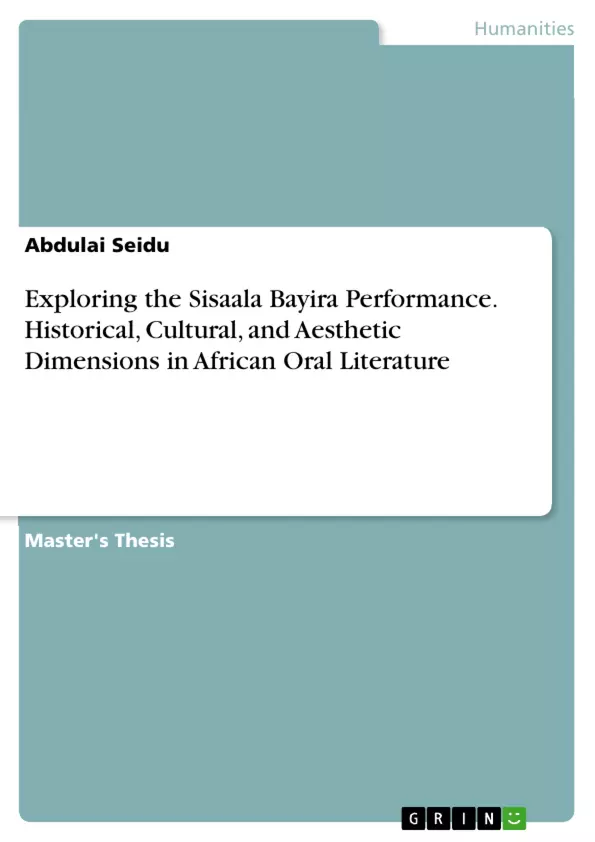This thesis was based on an ethnographic study of the Sisaala Bayira performance in context. The research was conducted in the Sisaala east, located at the north-eastern part of Ghana. The data was gathered through fieldwork on live Bayira performances during funerals at Walembelle and Tumu using participant observation and interviews as main research tools. The main objective of the study was an exploration of the role of the historical, cultural context and the aesthetic features embedded within Bayira performances and their contributions to African oral literature.
The theories which grounded the study were Tedlock’s and Schechner & Turner’s Performance Theories. Bayira performances were captured by audiovisual recordings, which were then translated from Sisaali into English using Peter Newmark’s Theoretical ideas on translation. They were coded and used for critical analysis. The results reveal that Bayira performances are embedded with aesthetic and symbolic representations, whereby Bayira performers use figurative language, histrionic gestures and other paralinguistic features as effective performance skills. The art of Bayira performance is tantamount to warfare whereby performers use pithy expressions to demonstrate panegyric skills, exhortation, admonition and trade in diatribes. The use of symbols ushers realism into the art of Bayira performance. Bayira performance has several pedagogical implications apart from moral lessons. Bayira songs teach communal and traditional values and comment on issues affecting the community and individuals in society. They teach people extended knowledge and wisdom by praising good behaviour and condemning unacceptable acts which are inimical to society.
Inhaltsverzeichnis (Table of Contents)
- CHAPTER ONE: INTRODUCTION
- 1.1. Overview of the Study
- 1.2. Background to the Study
- 1.3. Statement of the Problem
- 1.4. The Purpose of the Study
- 1.5. Significance of the Study
- 1.6. Objectives of the Study
- 1.7. Research Questions
- 1.8. Limitations to the Study
- 1.9. Delimitation to the Study
- 1.10. Organization of the Study
- 1.11. Chapter Summary
- CHAPTER TWO: LITERATURE REVIEW
- 2.1. Introduction
- 2.2. Definition of Technical Terms
- 2.2.1. Origin and Development of Bayira Performance
- 2.2.2. Appreciation of Bayira Performance by the Youth
- 2.3. The Background of the Sisaala people
- 2.4. Characteristics of African Oral Tradition
- 2.5. Major Features of Oral Tradition of the Sisaala people
- 2.6. The Concept of Death of the Sisaala People
- 2.7. Performance Culture in African Societies
- 2.8. Theoretical Framework
- 2.9. The Social Relevance of Bayira
- 2.10. The Stylistic Features of Bayira
- 2.11. Chapter summary
- CHAPTER THREE: METHODOLOGY OF THE STUDY
- 3.1. Introduction
- 3.2. Research Design
- 3.3. Population of the Study
- 3.3.1. Sampling Techniques Adopted
- 3.3.2. Research Instruments and Data Collection Procedures
- 3.4. Analytical Procedures Adopted
- 3.5. Chapter Summary
- CHAPTER FOUR: DATA ANALYSIS
- 4.1 Introduction
- 4.2. The Role of the Historical and Cultural Context of the Sisaala Bayira
- 4.3. The Aesthetic Features Embedded in Bayira Songs
- 4.4. The exploration of symbolic meanings and representations in Bayira performances
- 4.4.1. Recurrent themes foregrounded in the Ssaala Bayira performances
- 4.4. Chapter Summary
- CHAPTER FIVE: SUMMARY OF STUDY AND RECOMMENDATIONS
- 5.1. Introduction
- 5.2 Summary of the Entire Study
- 5.3 Evaluation of Research Findings
- 5.4. Final Conclusion
- 5.5. Recommendations
Zielsetzung und Themenschwerpunkte (Objectives and Key Themes)
This thesis aims to explore the Sisaala Bayira performance in its cultural context, specifically focusing on the historical, cultural, and aesthetic elements embedded within the performances. It examines how these elements contribute to African oral literature and seeks to understand the role of Bayira performances in the Sisaala community.
- The historical and cultural context of Sisaala Bayira performances
- The aesthetic features and symbolic elements embedded in Bayira performances
- The role of Bayira performances in preserving and transmitting Sisaala cultural values
- The pedagogical implications of Bayira performances
- The significance of Bayira performances within the broader context of African oral traditions
Zusammenfassung der Kapitel (Chapter Summaries)
- Chapter One: Introduction
- Chapter Two: Literature Review
- Chapter Three: Methodology of the Study
- Chapter Four: Data Analysis
This chapter introduces the research topic, providing a brief overview of the study's background, purpose, significance, and objectives. It also defines the research questions, limitations, delimitations, and outlines the study's organization.
This chapter reviews existing literature relevant to the study, defining key terms like "Bayira" and exploring the origins and development of this performance tradition. It also delves into the cultural background of the Sisaala people, examining characteristics of their oral tradition, their concept of death, and the broader context of performance culture in African societies. The chapter concludes by presenting the theoretical framework and exploring the social relevance and stylistic features of Bayira performances.
This chapter outlines the methodology employed in the research, including the research design, population of the study, sampling techniques, data collection procedures, and the analytical methods used.
This chapter presents the analysis of the data collected through fieldwork on live Bayira performances. It examines the role of historical and cultural context, explores the aesthetic features embedded in Bayira songs, and investigates the symbolic meanings and representations within the performances. It also highlights recurrent themes foregrounded in Sisaala Bayira performances.
Schlüsselwörter (Keywords)
The primary focus of this thesis revolves around the analysis of Sisaala Bayira performances, exploring their historical context, aesthetic features, and symbolic elements. The study delves into the intersection of oral tradition, performance culture, and cultural values within the Sisaala community. It examines how Bayira performances serve as a conduit for transmitting cultural knowledge, preserving traditions, and engaging with community issues. Key terms include: Sisaala Bayira, performance, historical, aesthetics, symbolic elements, oral tradition, cultural values, and pedagogy.
- Citar trabajo
- Abdulai Seidu (Autor), 2023, Exploring the Sisaala Bayira Performance. Historical, Cultural, and Aesthetic Dimensions in African Oral Literature, Múnich, GRIN Verlag, https://www.grin.com/document/1496149



